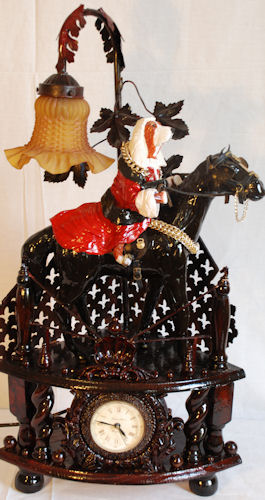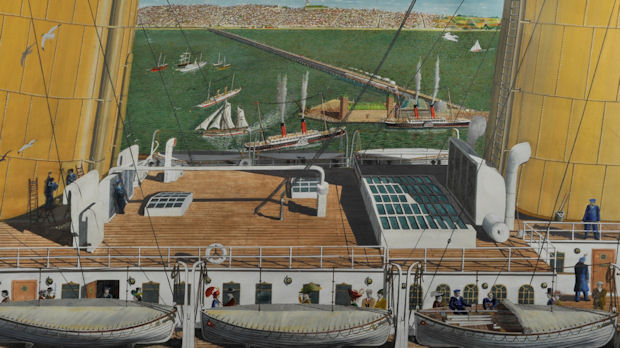Rapist’s sculpture sparks prisoner profit debate
The display of a sculpture created by one of Britain’s most dangerous sex offenders in a major exhibition has renewed the debate on whether criminals should be allowed to profit from their art.

Channel 4 News has learned that serial rapist Peter Thomas is the artist behind Sitting Proud, which he created whilst behind bars at HMP Dumfries, and the work is currently on display as part of the Koestler Trust’s Art By Offenders exhibition at the Royal Festival Hall at the Southbank Centre in London.
Thomas, 50, from Dumfries in Scotland, has a long history of violence and sex crimes including raping a young mother in front of her two-year-old daughter and assaulting an elderly woman, both in 1988.
He was jailed for 15 years in Shotts prison when he was sentenced in 1989; the first Scot to be convicted using DNA testing, and was released after serving two-thirds of his term. He has since reoffended but is now believed to be on probation.
Also currently on display is a painting of the Titanic by Denis Cochrane, a former London choirmaster at a leading Roman Catholic school, who is currently serving a five-year sentence in HMP Wandsworth for sexually assaulting a six-year-old girl.
In 2009, it was revealed that an anonymously-submitted sculpture bought by the Royal Festival Hall from the Trust had been made by Colin Pitchfork, who was serving life for killing two teenage girls.
The centre withdrew the item, publicly apologised and said that it would “have a conversation with the Koestler Trust about future policy.”
It later said it was reluctant to remove anonymously-submitted artworks, saying: “The Koestler Trust has a clear policy around anonymity, which we respect and abide by.”
But unlike Pitchfork’s work, in the current exhibition Thomas has included his name on a placard which accompanies his artwork.
Prison art and rehabilitation
Tim Robertson, the Chief Executive of the Koestler Trust, said that the crime of the artist is irrelevant.
“From our point of view, we don’t ask what their crime is, we don’t know,” he said.
“It’s up to the prisons and the establishments to decide whether it’s appropriate to send the art to us. We’re not there to judge people for their crimes. There are courts to do that, there are parole boards to do that. we simply judge them for their art.
He added: “Art is controversial. This year, we had a group of magistrates curating it, so we had the people who sentenced offenders looking at the art of offenders and bringing that to this exhibition.
“Of course that controversy is there and you couldn’t have an exhibition of art from prisons without it having a certain edginess and darkness to it but I would contrast that with a lot of the hope and colour and brightness and positive feelings that you find here too.
“Some of the artists themselves don’t want to be named because they don’t want people to know they’re in prison…and sometimes for security reasons, or because it might…cause distress to victims of crime, then the prison will decide not to name them.”
“We know that the arts world teaches offenders new skills, helps them build social relationships, learn discipline…all of those things that are likely to prevent re-offending in the future.”

But Kath Eastwood, whose daughter Lynda Mann, 15, was murdered by Pitchfork has long called for work by violent offenders to be removed, calling their inclusion in the exhibition “indecent”.
“Obviously, the work of a man who has committed that crime – which is just as horrific – shouldn’t be on display. I know what the parents must be feeling. It is indecent,” she said of Cochrane’s work.
And former prisoner Dean Stalham, the winner of several Koestler prizes himself who has also worked as an art specialist at the Trust, criticised the continued exhibition of work by sex offenders.
He said: “I am outraged by their continued celebration of paedophile’s and sex offenders work; it is unacceptable. The Koestler awards are a fine thing on the whole, but they need to change their policies in this regard.
“If sex offenders are segregated inside, and made to be on the sex offenders register on the outside, a similar discrimination should be forced upon their artwork, so that an otherwise unwitting public know their identities.”
He added: “Many say that art transcends all and that it has no boundaries, but in the real world you have to know where to draw the line, unfortunately the Koestler does not.”
The artists stand to receive 50 per cent of the proceeds from sale, with 25 per cent going back in to the Trust and 25 per cent to Victim Support.
And prison artwork has attracted some high-profile followers.
Last year, Thomas had a similar sculpture on display which was purchased by a high-ranking aristocrat who visited the exhibition.
The aristocrat paid around £700 for the piece, which won the Kalyx Outstanding Award. Thomas would have received around £350, under the Koestler Trust’s guidelines.
And former Deputy of the Metropolitan police, Brian Paddick, last year bought a drawing by a notorious sex offender called Robert Edwards, although the piece was submitted anonymously.
Mr Paddick explained that it was the meticulous style of the biro drawing that prompted him to buy it.
He said: “I was drawn to the overall look of it. I could see how much work had gone into it, the detail and intricacy.
“Being an advocate of rehabilitation initiatives in prisons, I was also interested in helping offenders show that there is a good side to everybody.”
“I can understand the arguments against particularly heinous prisoners being rewarded, but with incentives art can make prisons safer places and prisoners productive members of the community.”
The exhibition runs until 20 November. A Scottish version of the show will be on display in Edinburgh from November 5-27th.
A spokeswoman for the Southbank Centre said: “Southbank Centre supports the work and philosophy of The Koestler Trust and we are committed to hosting the annual Koestler exhibition, Art by Offenders, Secure Patients and Detainees, which this year has been curated by magistrates.”
-
Latest news
-
Parc Prison: Three inmates hospitalised ‘in riot’ over weekend – as one mother fears for son’s life4m

-
Nigel Farage: ‘People who say they will vote Labour won’t – when they see I’m here’4m

-
Nigel Farage to stand in general election – and becomes Reform UK leader3m

-
Exclusive: Channel 4 News obtains audio of Faiza Shaheen’s Labour candidacy interview

-
Are TikTok political campaigns winning over the youth?3m

-




